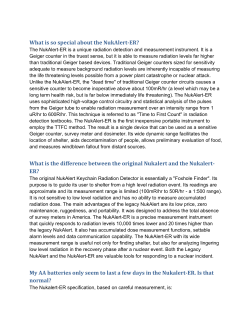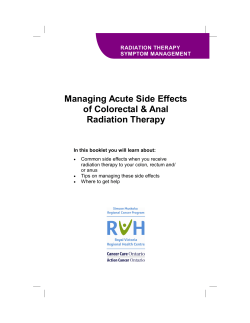
Radiation and You - What is the risk?
Radiation and You - What is the risk? Recent articles and news stories have raised questions concerning the benefits vs. the risk of medical imaging studies. Austin Radiological Association wants you to be informed about the risks of exposure, the steps our practice takes to ensure these risks are limited, what you can do to help, and where you can go for further information. Each of us is exposed to radiation every day of our lives. According to the Environmental Protection Agency, the average person in the United States receives a dose of about 360 millirem (used to measure radiation) per year. 80% of that comes from natural sources such as radon gas, the human body, outer space (cosmic radiation), soil, and rocks. The remaining 20% comes from man-made radiation sources, primarily medical imaging. As an example, the typical chest x-ray is equivalent to the amount of radiation one experiences from our natural surroundings in approximately 10 days. In the field of radiation protection, it is commonly assumed that the risk for adverse health effects from cancer is proportional to the amount of radiation dose absorbed and the amount of dose depends on the type of exam. Listed below are some common imaging modalities, the radiation risk associated with each, and an example of comparable risk. Each exam within a modality will vary in its radiation dose based on the body area examined, such as chest, abdomen, or extremity. Magnetic Resonance Imaging (MRI) uses NO radiation during the examination. MRI uses magnetic fields and radiofrequency waves to image the body. There is NO radiation risk involved with MRI. Ultrasound (US) uses NO radiation during the examination. Ultrasound uses sound waves to image the body. There is NO radiation risk involved with Ultrasound. X-ray uses a mild dose of radiation during the examination. A chest x-ray is equivalent to approximately 10 days of natural (background) radiation. Mammography uses a mild dose of radiation during the examination. A mammogram examination is equivalent to approximately 3 months of background radiation. Computed Tomography (CT) uses more radiation than a plain x-ray because it produces a more detailed image. Many of the recent news items have concerned CT, due to its growing use in diagnosing many disease processes. This diagnostic benefit may outweigh the radiation risk, so patients and their referring physician should consider these risks and benefits. Radiation exposure varies by CT procedure with an approximate range of 4 months to 3 years of equivalent background radiation. Nuclear Medicine uses small amounts of radioactive materials (RAM) which are either injected or swallowed to target certain organs or areas of the body for imaging. Radiation exposure is equivalent to approximately 1 year of background radiation. Positron Emission Tomography (PET) uses small amounts of radioactive materials (RAM) which are injected to image the body, typically to help diagnose or stage cancer in a patient. The radiation risk varies by procedure but is equivalent to approximately 4 years of background radiation. AU S T I N R A D I O LO G I C A L A SS O C I AT I O N What does Austin Radiological Association do to help limit your Radiation Exposure? • ARA has over 80 board certified radiologists, all of whom have extensive training in radiation safety and methods to limit radiation exposure for our patients. One physician serves as Radiation Safety Officer to provide leadership for our internal programs. • All of our technical staff have both national and state registration and certifications and are trained to monitor the radiation exposure of the equipment they use to perform your imaging. • The imaging equipment at all of our facilities is American College of Radiology (ACR) accredited. As a requirement of this accreditation, each unit is calibrated and monitored by our staff and a licensed medical physicist, as well as being serviced by factory qualified engineers. • Our practice supports The Alliance for Radiation Safety in Pediatric Imaging and the “Image Gently” Campaign to lower radiation dose in the imaging of children. • Our radiologists can confer with your physician to ensure the most appropriate imaging procedure is performed to avoid unnecessary radiation exposure. • Through our affiliation with the American College of Radiology and the American Board of Radiology we monitor the latest publications and trends so that we may quickly implement any new dose reduction guidelines. What can you do to help limit your Radiation Exposure? • Track your radiation exposure – as part of your medical history, keep a list of imaging procedures you have undergone, including type, date, and locations. • Discuss the exam with your physician – Why do I need this exam? How will having this exam improve my health care? Are there alternatives that do not use radiation which are equally as good? • Ask questions – is the facility providing your imaging accredited by an official organization such as the American College of Radiology (ACR)? Are the technologists certified? Are the physicians reading my exam subspecialized board certified radiologists? Where can you go for more information? • www.radiologyinfo.org - click on the safety link. Presented by the American College of Radiology (ACR) and the Radiological Society of North America (RSNA) • www.radiationanswers.org – Presented by the Health Physics Society • http://www.pedrad.org/associations/5364/ig/ - Image Gently – see parent section for pediatric imaging and what you can do • http://www.epa.gov/radiation/all.html#general – Environmental Protection Agency Contact Us: http://www.ausrad.com/ContactUs.aspx - Austin Radiological Association BUSINESS OFFICE 10900 Stonelake Boulevard Suite A-250 Austin, Texas 78759 (512) 795-5100 SCHEDULING: (512) 458-9098 FAX REFERRALS: (512) 836-8869 www.ausrad.com
© Copyright 2025













